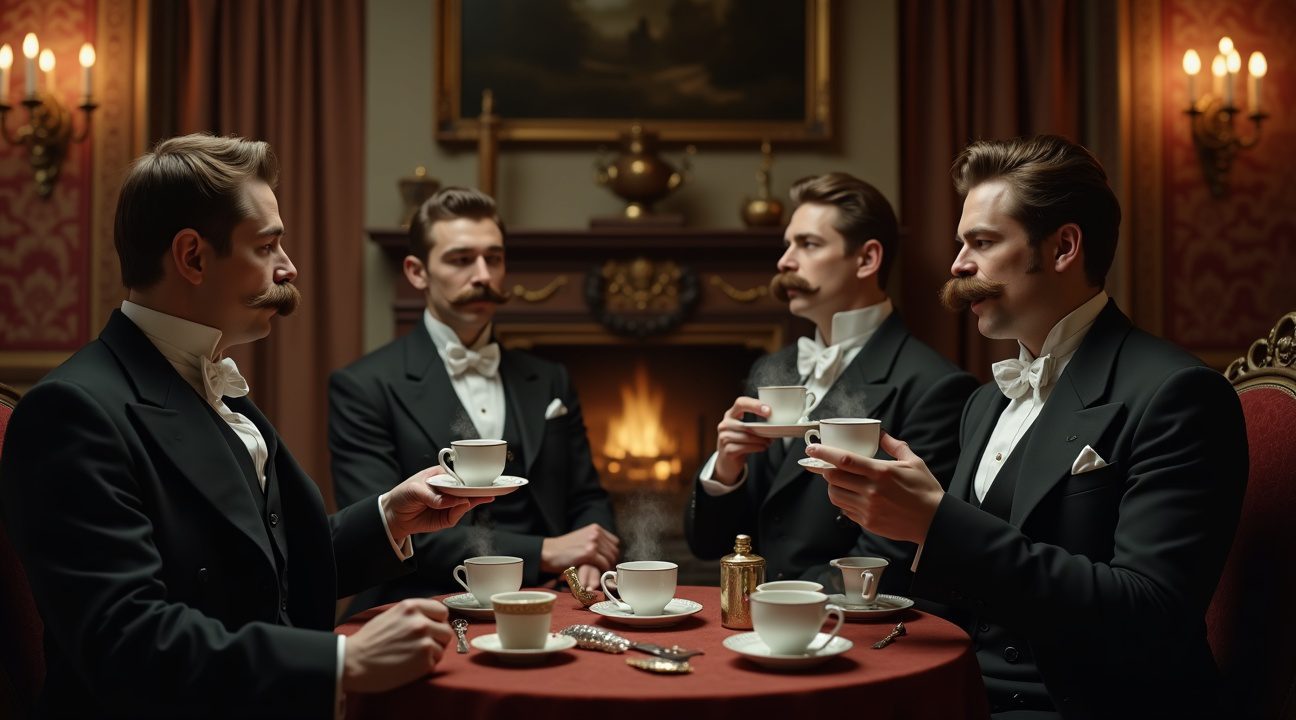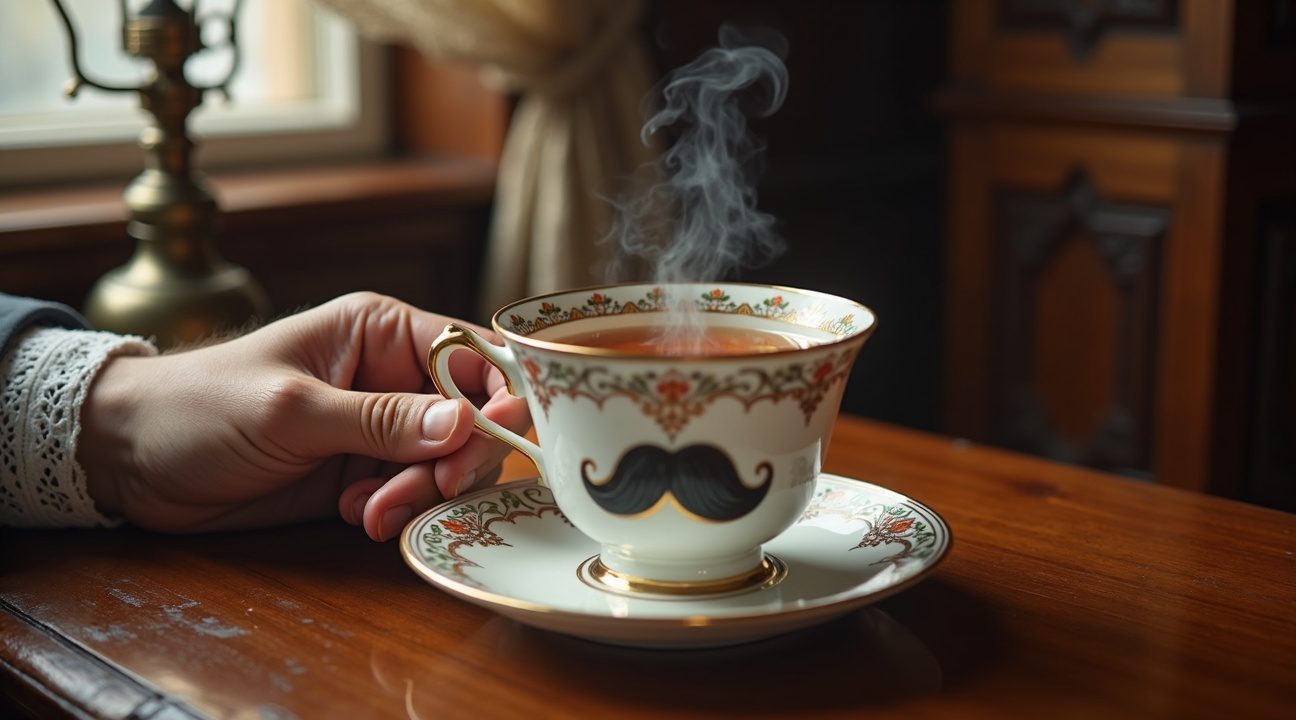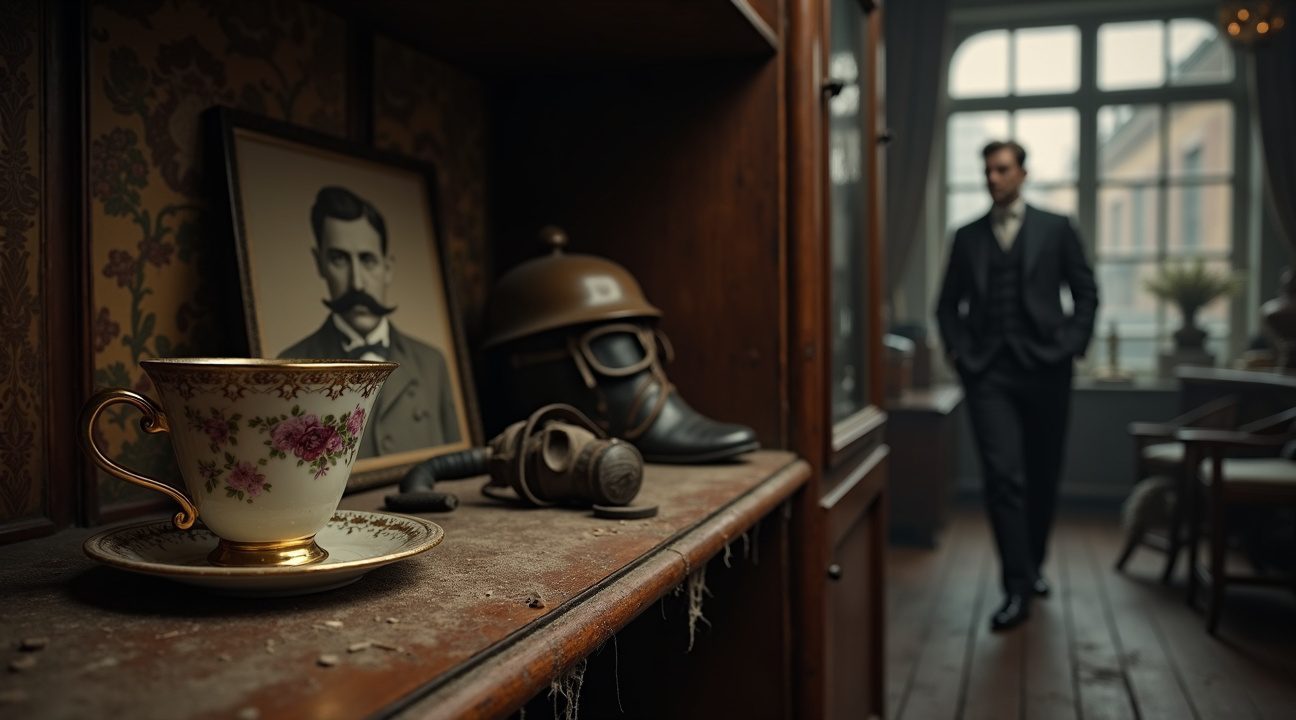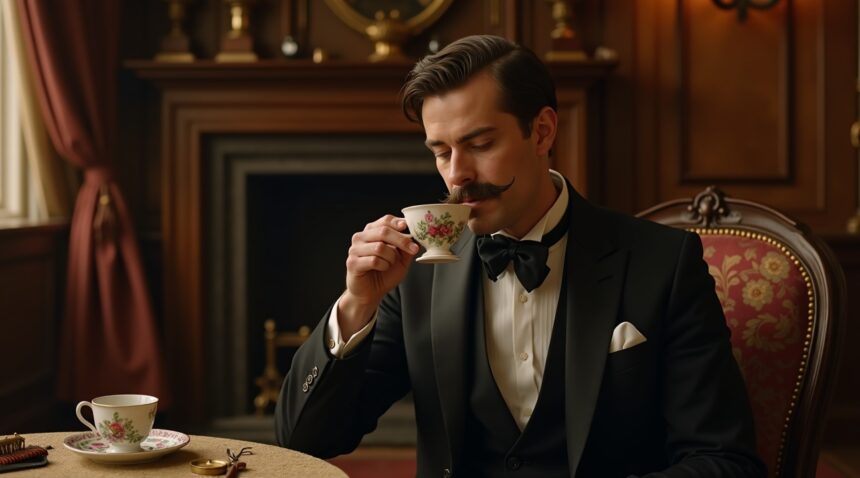Victorian Britain encountered an unusual dining challenge when elaborate moustaches became the pinnacle of masculine fashion.
Steam and heat from tea and coffee melted the wax styling products, causing embarrassing drips into beverages during social gatherings. British potter Harvey Adams addressed this problem in the 1860s by creating the moustache cup, which featured a built-in ledge or guard. This innovation protected carefully groomed facial hair while allowing gentlemen to drink their hot beverages without compromising their appearance.
Key Takeaways
- The moustache cup featured a semicircular ledge inside the rim that created a barrier between facial hair and hot beverages, with openings shaped like half-moons or butterflies to allow liquid flow while keeping moustaches dry.
- Major pottery manufacturers across Europe and America including Meissen, Royal Crown Derby, and Limoges produced these cups in various materials from fine porcelain to practical tin, making them accessible across different social classes.
- The cups became essential household items from 1860 to 1916 during the peak of Victorian moustache fashion, when elaborate facial hair served as symbols of masculinity and social status requiring specialized grooming tools and accessories.
- World War I effectively ended the moustache cup era as military gas mask requirements and trench warfare conditions made elaborate facial hair impractical and dangerous, leading to clean-shaven faces becoming the new masculine standard.
- Victorian craftsmen transformed these functional items into decorative art pieces featuring hand-painted landscapes, intricate floral patterns, and ornate guards that demonstrated both artistic skill and practical innovation.
Today, moustache cups are considered cherished collectibles, often displayed in museums and private collections. Institutions like the Victoria and Albert Museum honor these unique items as examples of Victorian ingenuity and cultural expression.
The Ingenious Solution to a Victorian Gentleman’s Drinking Dilemma
British potter Harvey Adams recognized a pressing problem facing fashionable gentlemen of his era and created the moustache cup during the 1860s or 1870s. This specialized drinking vessel featured a built-in ledge or guard that protected carefully groomed facial hair from steam and liquid while consuming hot beverages like tea and coffee.
Drawing Room Disasters and the Need for Innovation
Victorian gentlemen faced considerable embarrassment during social gatherings as steaming hot drinks posed a constant threat to their elaborate facial hair. The steam from hot tea or coffee would melt the wax used to shape their moustaches, causing both wax and dye to drip directly into their beverages. These drawing room disasters created awkward moments and ruined perfectly good refreshments, prompting the need for a practical solution.
Adams’ invention addressed this specific challenge by incorporating a small shelf or ledge across the cup’s opening. This barrier allowed gentlemen to sip their beverages while keeping their moustaches elevated and protected from both steam and direct contact with the liquid.
The Victorian Gentleman’s Grooming Arsenal
The elaborate facial hair maintenance of Victorian men required an extensive collection of specialized tools and products. Gentlemen employed various items to achieve their desired look:
- Wax for shaping and holding moustache styles in place
- Dye to enhance color and coverage
- Fine combs designed specifically for facial hair styling
- Specialized brushes for daily maintenance and grooming
- Protective nets worn overnight to preserve carefully crafted shapes
- Precision scissors for trimming and shaping
The importance of facial hair became so significant that by the early twentieth century, maintaining a moustache wasn’t just fashionable—it became mandatory for British Army soldiers in certain circumstances. This requirement demonstrates how central moustache grooming had become to masculine identity and professional appearance.
Harvey Adams’ moustache cup represented more than just a novelty item; it solved a genuine practical problem that affected countless Victorian gentlemen daily. The innovation allowed men to enjoy their hot beverages without compromising their carefully maintained appearance or enduring the social embarrassment of wax-tainted drinks. These cups became essential accessories for any well-appointed gentleman’s table service, reflecting the era’s dedication to both proper etiquette and impeccable grooming standards.

How the Moustache Guard Actually Worked
The ingenious design of Victorian moustache cups centered around a simple yet effective feature called the moustache guard. This semicircular ledge was positioned strategically inside the cup, creating a protective barrier between facial hair and hot beverages. I find it remarkable how this small addition solved a significant social problem of the era.
The guard itself featured a distinctive opening that varied in shape depending on the manufacturer’s aesthetic preferences. Most commonly, craftsmen created half-moon or butterfly-shaped openings that allowed liquid to flow through while keeping moustaches completely dry. The butterfly design became particularly popular, with its elegant curves adding both function and beauty to the drinking experience.
The Mechanics of Moustache Protection
When a gentleman lifted the cup to drink, his moustache would naturally rest on the semicircular ledge. The liquid would then pass through the carefully crafted opening, flowing directly into his mouth without any contact with facial hair. This system worked so effectively that many described it as functioning like an adult sippy cup, though such comparisons weren’t made during the Victorian period.
The ledge often showcased ornate decorative elements, transforming what could have been a purely functional component into an artistic feature. Porcelain manufacturers took pride in creating these “secret shelves” with intricate patterns and delicate details. Some guards were so beautifully crafted that they resembled miniature works of art hidden within the cup’s interior.
Cup dimensions varied among manufacturers, but a typical example measured approximately 3 1/16 inches (7.8 cm) in height and 4 3/8 inches (11.1 cm) in width when including the handle. These proportions provided the perfect balance between functionality and comfort, ensuring that the moustache guard could accommodate facial hair of various lengths and styles.
The practical innovation behind these cups extended beyond mere convenience. During an era when elaborate moustaches served as symbols of status and masculinity, maintaining their appearance throughout the day became essential. Hot beverages, particularly tea and coffee, posed a constant threat to these carefully groomed facial accessories. Wax and pomades used to style moustaches could melt or become displaced when exposed to steam and liquid.
Manufacturing techniques of the time allowed for remarkable precision in creating these specialized drinking vessels. Craftsmen would mold the guard as an integral part of the cup during the initial forming process, ensuring seamless integration with the overall design. The butterfly-shaped opening required particular skill to execute properly, as the curves needed to be smooth enough for comfortable drinking while maintaining structural integrity.
Different manufacturers experimented with various guard configurations. Some created wider ledges for gentlemen with particularly substantial moustaches, while others focused on more delicate designs for those with modest facial hair. The positioning of the opening also varied slightly, with some placing it higher or lower depending on the intended user’s preferences.
The cups gained popularity across social classes, though the most ornate examples were reserved for wealthy households. Middle-class families often owned simpler versions that maintained the essential moustache guard functionality without elaborate decorative flourishes. These practical designs proved just as effective as their more expensive counterparts.
Interestingly, the guard’s effectiveness depended partly on the drinker’s technique. Users learned to position their lips precisely at the opening while allowing their moustache to rest naturally on the ledge. This required some practice, but most gentlemen quickly mastered the proper drinking method.
The moustache guard represented a perfect marriage of form and function during an era that valued both aesthetic beauty and practical solutions. These cups demonstrate how Victorian ingenuity could transform everyday challenges into opportunities for elegant design innovations that served real purposes in daily life.

From Luxury Pottery Houses to Department Store Shelves
Following Adams’s revolutionary invention, prestigious pottery manufacturers across Europe and America embraced the moustache cup concept with remarkable enthusiasm. Between 1850 and 1900, renowned houses like Meissen, Royal Crown Derby, Imari, Royal Bayreuth, and Limoges transformed this practical necessity into exquisite works of art. These established potteries recognized the commercial potential and elevated the humble moustache cup from a simple household item to a coveted collectible.
Materials and Manufacturing Excellence
Craftsmen employed diverse materials to create these distinctive vessels, demonstrating remarkable versatility in their approach. Options included traditional earthenware and fine porcelain alongside durable stoneware, practical tin, and elegant silverplate finishes. Sizes varied dramatically to accommodate different social classes and drinking preferences, ranging from delicate demitasse cups perfect for afternoon tea to substantial farmers’ cups that could hold up to a full quart of liquid.
The variety in materials reflected both economic accessibility and social status. While working-class families might purchase sturdy tin or earthenware versions, wealthy households often displayed ornate porcelain or silverplate examples as symbols of sophistication and modern thinking.
Market Expansion and Decorative Artistry
These cups quickly gained popularity throughout the UK before spreading across European markets and eventually reaching American shores. Major American retailers recognized the trend’s potential, with Sears, Macy’s, and Marshall Field’s featuring moustache cups prominently in their catalogs and store displays. This widespread availability made the cups accessible to middle-class households across different continents.
Decorative elements elevated these functional pieces into artistic treasures. Manufacturers produced cups featuring hand-painted landscapes that transported drinkers to serene countryside scenes, while others showcased intricate floral patterns and geometric designs. Portrait cups became particularly sought-after collectibles, often featuring famous figures or family members. German manufacturers gained special recognition for their distinctive luster grounds, which created shimmering, iridescent surfaces that caught and reflected light beautifully.
The transformation from Adams’s simple prototype to mass-produced household staples demonstrates how practical innovation can evolve into cultural phenomena. These cups became conversation pieces that reflected both personal style and social awareness, proving that even the most mundane daily activities could benefit from thoughtful design improvements.
The Golden Age of Moustache Etiquette
From approximately 1860 to 1916, moustache cups became an essential component of every proper household tea service across Victorian society. These specialized vessels weren’t merely decorative accessories but represented a practical solution to maintaining the elaborate facial hair that dominated masculine fashion during this remarkable period.
Victorian gentlemen invested considerable time and resources into the art of pogonology — the scientific study and cultivation of facial hair. This dedication extended far beyond simple grooming into a complex daily ritual that reflected social status and personal refinement. Men would carefully apply wax, use specialized dyes to maintain color consistency, and engage in frequent grooming sessions to achieve the perfect whisker presentation.
A Flourishing Market for Masculine Accessories
The popularity of moustache cups coincided with a broader market explosion for grooming-related accessories unique to this era. Victorian households commonly featured these specialized items:
- Moustache brushes crafted from premium bristles for daily maintenance
- Protective nets worn during sleep to preserve carefully styled whiskers
- Grooming sets containing various waxes and conditioning treatments
- Specialized combs designed for different facial hair textures
- Storage cases to organize the complete grooming arsenal
Tea etiquette during this period demanded that gentlemen maintain their carefully cultivated appearance even during social gatherings. Entertainment culture of the time reinforced these standards, making facial hair maintenance a visible marker of Victorian masculinity and social refinement.
The moustache represented more than personal style — it embodied the era’s complex relationship with tradition, innovation, and social expectations. Men who invested in proper grooming accessories, including the essential moustache cup, demonstrated their commitment to the sophisticated standards that defined Victorian society. This attention to detail in personal presentation reflected broader cultural values that emphasized order, respectability, and the careful cultivation of one’s public image.
The decline of moustache cups after 1916 marked not just a shift in facial hair trends but a fundamental change in how society viewed masculine presentation and domestic rituals.
Why the Moustache Cup Vanished After the Great War
The once-essential moustache cup met its demise not through changing fashion alone, but through the harsh realities of global warfare. World War I fundamentally transformed men’s grooming habits in ways that would permanently alter Victorian-era traditions.
Wartime Practicality Trumped Victorian Elegance
Trench warfare created conditions that made elaborate facial hair not just impractical, but dangerous. Soldiers discovered that their carefully waxed moustaches interfered with the proper seal of gas masks, a life-or-death concern in chemical warfare. Military regulations began requiring clean-shaven faces or closely trimmed facial hair to ensure protective equipment functioned correctly.
The cramped, unsanitary conditions of trenches made maintaining the elaborate moustache styles of the Victorian era nearly impossible. Men who had once spent considerable time grooming their facial hair found themselves in environments where basic hygiene became a luxury. Water for washing was scarce, and the tools needed for proper moustache maintenance were considered non-essential equipment.
The End of Moustaches as Status Symbols
Before WWI, elaborate moustaches served as symbols of masculinity, social status, and sophistication. Men proudly displayed their carefully groomed facial hair much like Mario and Luigi showcase their distinctive mustaches today. However, the war shifted cultural values toward practicality and efficiency over ornamental displays.
The post-war generation embraced a cleaner, more streamlined aesthetic that reflected the mechanized age. Young men returning from military service maintained their clean-shaven appearance, associating elaborate facial hair with an outdated pre-war mentality. This cultural shift rendered the moustache cup obsolete almost overnight.
Clean-shaven faces became the new standard of modern masculinity, much like how cultural trends can shift rapidly in contemporary entertainment. The practical needs of wartime had permanently altered men’s relationship with facial hair, making the specialized drinking vessels unnecessary.
Manufacturing priorities during and after the war also contributed to the moustache cup’s disappearance. Factories that had produced these decorative items redirected their efforts toward military supplies and post-war reconstruction needs. The resources and attention once devoted to such specialized items were channeled into more essential products.
The decline accelerated as social customs evolved. Tea-drinking rituals became less formal, and the elaborate etiquette that had necessitated special drinking vessels gave way to more casual dining habits. The precision required for using moustache cups seemed unnecessarily fussy to a generation that had experienced the realities of modern warfare.
Barbershops, which had once served as centers for elaborate grooming rituals, adapted to serve clients seeking quick, efficient haircuts and shaves. The time-intensive process of styling and maintaining elaborate moustaches became viewed as an antiquated practice from a bygone era.
The psychological impact of the war cannot be understated in this transformation. Men who had witnessed unprecedented destruction and loss found little appeal in the ornate customs of Victorian society. Simple, functional approaches to daily life replaced the decorative flourishes that had characterized pre-war culture.
By the 1920s, the moustache cup had become a curious relic, occasionally found in antique shops but no longer produced for everyday use. The rapid shift in facial hair trends, driven by wartime necessity, had eliminated the market for these specialized drinking vessels. Unlike other Victorian-era items that gradually fell out of favor, the moustache cup’s disappearance was swift and decisive, tied directly to the practical demands of global conflict and the cultural changes that followed.

The Craftsmanship Behind Victorian Moustache Cups
Victorian craftsmen elevated the humble drinking vessel into an art form through their work on moustache cups. I find it fascinating how these practical items became canvases for elaborate decorative techniques that showcased the era’s finest artistic traditions. Skilled artisans transformed simple porcelain blanks into masterpieces featuring hand-painted landscapes that transported drinkers to serene countryside scenes with every sip.
The decorative artistry extended far beyond basic functionality. Craftsmen applied intricate floral motifs that ranged from delicate rosebud clusters to bold botanical arrangements sprawling across the cup’s surface. Geometric patterns provided another popular design avenue, with artists creating complex tessellations and repeating motifs that demonstrated mathematical precision combined with aesthetic appeal. These decorated surfaces required multiple firing stages, with each layer of paint and glaze carefully applied to achieve the rich, lustrous finish that collectors prize today.
Material Diversity and Manufacturing Excellence
Victorian manufacturers understood that different customers required different solutions, leading to an impressive range of materials and construction methods.
- Fine porcelain represented the pinnacle of quality, with manufacturers like Spode and Royal Crown Derby producing cups that rivaled the finest china services. These pieces often featured translucent walls so thin that light could pass through them, yet remained durable enough for daily use.
- Earthenware provided a more accessible option without sacrificing decorative potential. These cups allowed for bold color applications and experimental glazing techniques.
- Stoneware versions served working-class customers who needed durability above all else.
- Tin and silverplate options offered unique aesthetic qualities and different price points.
The size variations reflected the diverse drinking habits of Victorian society:
- Tiny demitasse cups catered to formal afternoon occasions where small portions of strong coffee were preferred.
- Large farmers’ cups could hold substantial quantities of tea or coffee needed to fuel long working days.
These size differences often correlated with the complexity of decoration—smaller cups typically featured more intricate detailing per square inch.
The moustache guards themselves became focal points for artistic expression. Rather than simple functional barriers, craftsmen shaped these elements into decorative features that enhanced the overall design. Butterfly-shaped guards represented perhaps the most whimsical approach, with delicate wing patterns etched or painted onto the metal surface. Some guards featured scrollwork that echoed the cup’s painted motifs, creating visual harmony between all elements.
Silverplate guards offered particular opportunities for embellishment through engraving and embossing techniques. Craftsmen could create textured surfaces that caught light differently throughout the day, adding visual interest even when the cup sat empty. The attachment methods varied as well, with some guards permanently fixed during manufacturing while others could be removed for thorough cleaning.
The broad market appeal of these specialized vessels encouraged manufacturers to experiment with production techniques that balanced quality with affordability:
- Transfer printing allowed for consistent reproduction of popular patterns across multiple pieces.
- Hand-painting remained reserved for premium examples.
This tiered approach meant that virtually anyone with facial hair could access the practical benefits, regardless of their economic circumstances.
Quality control during the Victorian era emphasized both functional performance and aesthetic appeal. The moustache guard had to maintain its position securely while not interfering with the drinking experience. Craftsmen tested lip placement, liquid flow rates, and guard angles to ensure optimal performance. The decorative elements needed to withstand repeated washing and daily handling without fading or chipping.
Production records from major pottery centers like Staffordshire reveal the scale of demand for these specialized items. Manufacturers produced thousands of units annually, suggesting that moustache cups weren’t merely novelty items but essential accessories for well-groomed Victorian gentlemen. The variety in decoration and materials reflected both the era’s manufacturing capabilities and the sophisticated tastes of consumers who expected their everyday objects to demonstrate artistic merit alongside practical functionality.
Sources:
Wikipedia, “Moustache cup”
Rosenberg Library Museum, “Nineteenth Century Mustache Cups”
U.S. National Park Service, “Mustache Cups: Fancy Function or Frivolousness?”
Snopes.com, “These Victorian-Era Cups Kept Men’s Mustaches Clean”
Atlas Obscura, “Mustache Cups”
Bunk History, “Victorian Moustache Cup”
History Facts, “Victorian England had special teacups for men with mustaches”


